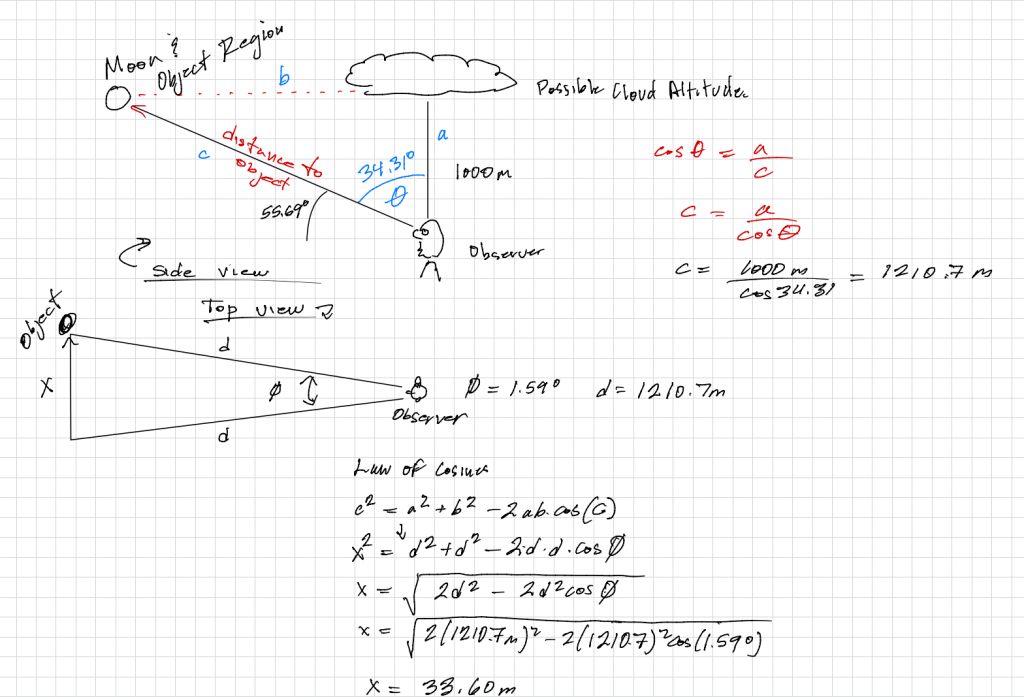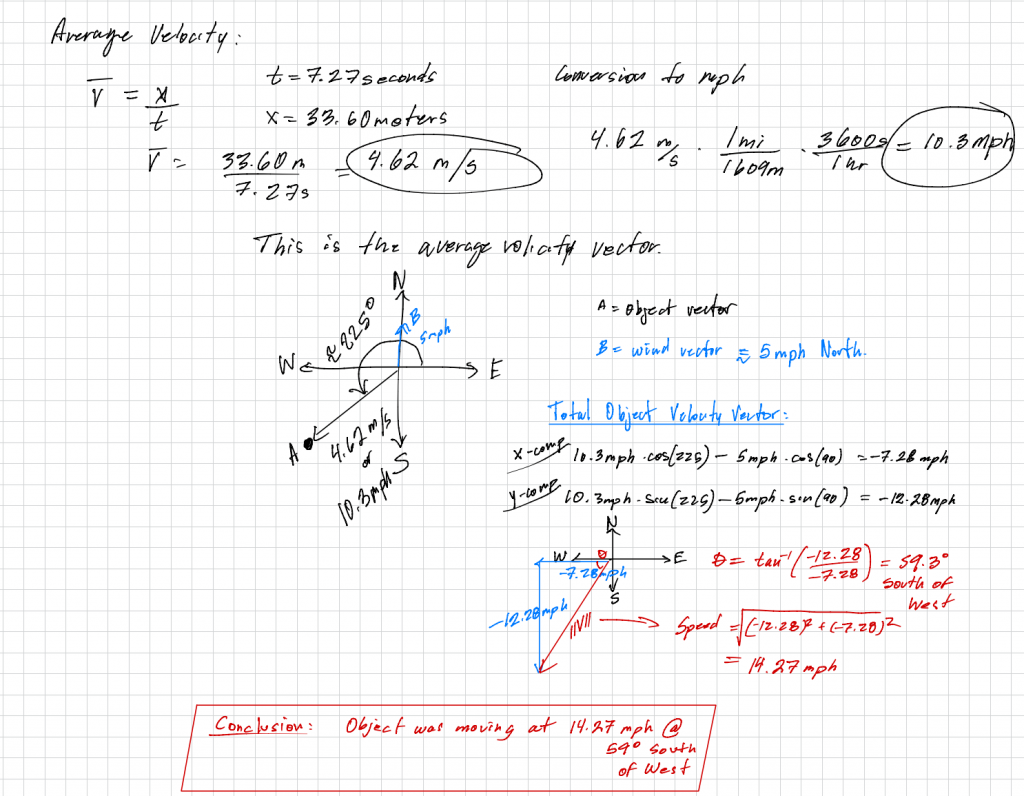Once in a while, we encounter a report with video and enough data to perform calculations that give us insight into what we are looking at. When we saw this video sighting, at first it looked very impressive and we also noticed that we have enough here to extract further details about the object, such as estimations of its velocity.
The video can be found here: https://www.youtube.com/watch?v=Dn8oReWpo9E
As you will see, after further analysis, this UFO turned out to be less impressive than we originally thought, and the entire sighting can probably be explained as the sighting of someone’s drone with an LED light aimed towards the observer. I imagine that this drone might have been taking pictures or something. Or perhaps, there really is something interesting going on here. Whatever the case, lets proceed to get the math done, and obtain some good estimates.
In this analysis, I will be determining the approximate velocity of the UFO aka UAP at a specific point in the video, where the object appeared to show impressive movement characteristics.
THE MOON RUSH
This is the moment starting at around minute 1:37, where the UFO quickly moves toward the moon.

Screenshot of the initial frame as it begins its movement.
I will use a stopwatch to determine the exact time it took it to travel a certain distance in the sky.
The moon measures a certain amount in terms of arcseconds. An arcsecond is a unit of angular measurement equal to 1/3600 of a degree. It is commonly used in fields like astronomy, geodesy, cartography, optics, and physics to measure very small angles with high precision.
The apparent size of the Moon in the sky can be expressed in arcseconds. On average, the apparent diameter of the Moon is about 31 arcminutes, which = 1860 arcseconds on average. The radius of the moon is therefore 930 arc seconds on average. This will be how we will make our ruler.
In the image, the ruler measures 70 pixels:

We here begin to use pixels to measure arcseconds, a method of carefully measuring angles when looking at the sky. The Moon measures a specific number of arc seconds. Thanks to the presence of the moon in the video, we can extract information about the object.
70px = 930arcsec
Next, I have super imposed the images to capture the object’s position. You will notice the clouds don’t perfectly match, because the clouds are moving relative to the moon, but the moon is what we care about here. Using photoshop, I will measure the number of pixels of displacement of the object and convert them to arcseconds.

This shows the object in both places, in other words, its initial position and its final position during the time frame we are focused on.

Zooming in a bit more.
We get a horizontal displacement of about 430px and vertical of 43px.

Zooming In!
Lets do some calculations:
Obtaining the hypotenuse and converting to arc seconds:
Hypotenuse: (4302 + 432)1/2 = 432px approximately.
The object moved in a nearly straight line from the observer’s perspective, but it likely moved in a straight line from its own perspective. We will therefore assume it moved about 432px.
432px/70px = 6.17
6.17 * 930arcsec = ~5740 arcsec
5740 arcseconds is the angle the object moved.
1 arcsec = 1/3600 of a degree.
(5740 arcsec) * (1degree)/(3600 arcseconds) = 1.59 degrees.
Timing of the movement: 7.27seconds approximately. The object took that long to travel that angle.
Determining distances:
Research by Eschaton indicates that the moon was at 55.69 degrees altitude that day. We also determined that the clouds observed are cumulus clouds, and they can be as low as 1000 meters from the ground. This represents a lower bound on the object’s height. The object could be higher, but it won’t be higher than the clouds as it appears to fly under the clouds. We will proceed with these estimates to create further understanding of the object’s motion.



Using the moon angle and also the lowest altitude of the clouds, we can come up with an estimate of distance to the object, then we can use the angle it displaced to determine its average velocity over that interval.


As you can see above, the object was likely moving only about 14.27 miles per hour, even accounting for wind.
This velocity appears much more impressive in the zoomed in video, but sadly it really is not that impressive in reality. Small drones can easily achieve those velocities.
The jerking or angular looking movement of the object in the sky, can then easily be explained by the movement being requested by the drone’s operator on the ground, as they push the control stick in their desired direction, possibly as they position the drone better for their picture or personal preference.
The distant observer saw the small object, and recorded it on their phone, and this is how we got this cool video of an apparently anomalous object. However, the most anomalous thing about this object has turned out to be the difficulty in identifying lights. The movement itself has turned out to be underwhelming.
This case is a great example of an interesting video that unfortunately captured a relatively mundane situation, but the lighting and apparent movement of the object makes it look anomalous, when it is not.
Lastly, I would like to leave you with a couple more thoughts. It is possible that these clouds are much higher, but they will not be a thousand times higher or any sufficient altitude that causes the movement of this object to be a lot more impressive. Even if the object were moving at 300mph, that would be within normal drone velocities parameter. So ultimately, the object’s movement is truly not that impressive. But does its lack of impressive movement make it clear that this object is not anomalous? I don’t know. We have numbers now, and we have a candidate of what it could be: a remotely operated drone, but it doesn’t mean that an anomalous object could not be piloted in such an unimpressive way by an NHI. Indeed, this is not evidence that it is not anomalous, but it is evidence that it’s Velocity is not anomalously high. In the end, we must make up our own minds for now, or not, that’s the beauty of science, and we can simply wait for more data to present itself.
And with that, I say good bye for now, and I wish you happy exploration of the unknown.
Xenotic Entity
